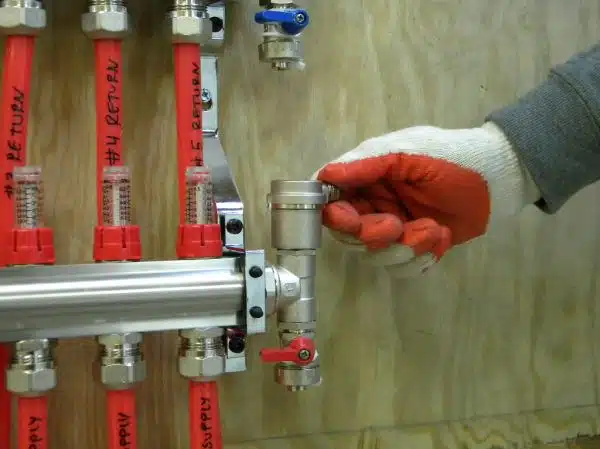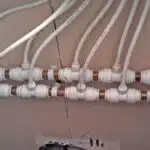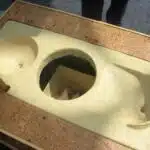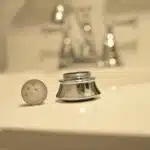PEX tubing is a popular choice for plumbing and hydronic heating systems due to its flexibility, durability, and ease of installation. However, there are times when PEX tubing needs to be bent to accommodate the layout of a system or to fit around obstacles. Properly bending PEX tubing is essential for ensuring that it maintains its structural integrity and does not crack or leak.
In this article, we will discuss the various methods for bending PEX tubing and provide tips on how to do it safely and effectively. Whether you are a DIY homeowner or a professional plumber, mastering the art of bending PEX tubing will help you complete your projects with confidence and precision. So if you’re ready to learn how to bend PEX tubing like an expert, read on!
Understanding Pex Tubing
As the old adage goes, “knowledge is power.” To successfully install and maintain a plumbing system with PEX tubing, it’s crucial to understand the advantages of this material. Compared to traditional copper piping, PEX tubing boasts several benefits that make it an attractive option for contractors and DIY enthusiasts alike.
First and foremost, PEX tubing is incredibly flexible and easy to work with. This flexibility allows for more straightforward installation in tight spaces and around corners without requiring as many fittings or connectors. Additionally, PEX tubing is resistant to corrosion and scale buildup, which can cause blockages in traditional metal piping systems. It’s also less prone to freezing, making it an ideal choice for colder climates.
While there are certainly advantages to using PEX tubing over copper piping, it’s important to note that proper installation techniques must be followed for optimal performance. One critical consideration is the importance of properly bending the tubing without causing damage or kinks. Improper bending could lead to leaks or reduced water flow rates along with overall system failure.
In summary, understanding the benefits of PEX tubing over copper piping is essential knowledge for any plumbing professional or DIY enthusiast. However, these advantages are only achievable if proper installation techniques are used in conjunction with appropriate bending methods that don’t compromise the integrity of the material. In the following section, we’ll explore why correct bending techniques play such a vital role in ensuring reliable performance from your PEX tubing system.
The Importance Of Proper Bending Techniques
Creating smooth bends when working with pex tubing is essential to ensure long-term performance and reliability. It is important to use the proper bending tools and techniques to ensure the tubing is not kinked or cracked. Careful technique is needed to avoid the tubing becoming brittle and prone to cracking due to tight radius bends. When bending pex tubing, it is important to use a gradual radius and avoid any sharp bends in order to prevent kinking or cracking.
Creating Smooth Bends
When it comes to working with PEX tubing, there are several techniques for precision bending that can help ensure the best results. Achieving uniformity in bends is an important aspect of proper bending techniques, as it can prevent leaks and other issues down the line. One key technique for creating smooth bends is to use a quality bending tool designed specifically for PEX tubing.
Another technique that can be helpful in achieving uniformity is to mark the tubing before making the bend. This can be done using a marker or similar tool, and can help ensure that each bend is made at the same angle and distance from the previous one. Additionally, taking care to support the tubing properly during the bending process can help prevent kinks or other deformities.
Overall, mastering proper bending techniques is essential for anyone working with PEX tubing. By taking steps to achieve uniformity and create smooth bends, you can ensure that your plumbing projects are completed correctly and without issue. With practice and attention to detail, anyone can become skilled at bending PEX tubing with precision and ease.
Avoiding Kinks And Cracks
Proper bending techniques are essential when working with PEX tubing, as they help prevent common mistakes such as kinks and cracks. These deformities can weaken the tubing and cause leaks or other issues down the line. It is important to take steps to prevent damage and ensure durability when bending PEX tubing.
One troubleshooting technique for avoiding kinks and cracks is to support the tubing properly during the bending process. This can be done using a bending tool or by hand, but it is important not to apply too much pressure or force that could cause deformities. Additionally, taking care to bend slowly and gradually can help prevent sudden changes in direction that could lead to kinks or cracks.
Another key technique for ensuring durability is to avoid over-bending the tubing. This can cause stress on the material and weaken it over time, which could eventually lead to failure. By taking care to make precise bends at appropriate angles, you can ensure that your plumbing projects are completed correctly and without issue. With practice and attention to detail, anyone can become skilled at avoiding kinks and cracks when bending PEX tubing with precision and ease.
Types Of Pex Tubing
Proper bending techniques are essential when working with PEX tubing. However, it is equally important to understand the different types of PEX tubing available. Two categories of PEX tubing are cross-linked and non-cross linked. Cross-linked PEX tubing is more resistant to high temperatures and pressure, which makes it a better option for hot water systems. Non-cross linked PEX tubing is suitable for cold water systems and is less expensive than its counterpart.
Another significant difference between PEX tubing types is the manufacturing process used to create them. PEX A and PEX B are two methods used to manufacture cross-linked polyethylene tubes. The PEX A method produces a more flexible tube that can withstand higher temperatures and has better chemical resistance. In contrast, the PEX B method produces a stiffer tube that can bend easily in any direction without kinking.
In conclusion, understanding the different types of PEX tubing available helps you choose the right one for your specific needs. Cross-linked vs non-cross linked and PEX A vs PEX B are two factors that influence your decision-making process when selecting the right type of tube for your project. In the next section, we will discuss the tools you’ll need for bending pex tubing so that you can complete your plumbing installation with accuracy and precision.
Tools You’ll Need For Bending Pex Tubing
Symbolism can be a powerful tool in plumbing. Just as a wrench symbolizes tightening and loosening, certain tools represent the process of bending PEX tubing. By understanding the purpose and function of these tools, you will be better equipped to handle any job that comes your way.
One essential tool for bending PEX tubing is a PEX tubing cutter. These cutters are specifically designed to make clean cuts on PEX tubing without causing any damage to the pipe itself. This is important because any damage or rough edges can cause leaks or other issues down the line. Along with a PEX tubing cutter, you’ll also need measuring tools such as a tape measure or ruler to ensure accurate cuts and bends.
Another important tool for bending PEX tubing is a bending tool. These come in various shapes and sizes depending on the diameter of your PEX tubing, but they all serve the same purpose: to create smooth and accurate bends in your piping. Some popular types of bending tools include coil benders, straighteners, and hand benders.
In addition to these tools, it’s also important to have safety equipment on hand when working with PEX tubing. Gloves and eye protection should always be worn when handling sharp cutting tools or hot water during installation. By having all of these tools at your disposal, you’ll be able to bend PEX tubing with ease and precision while avoiding any potential hazards along the way.
To prepare the tubing for bending, there are several steps you need to follow. First, measure out the length of tubing you need using your measuring tools. Then use your PEX tubing cutter to make a clean cut at both ends of the tube. Once this is done, mark where you want your bends to be using a marker or piece of tape before using your bending tool to create smooth arcs in each section of tubing as needed.
Preparing The Tubing For Bending
To prepare the tubing for bending, you must first consider its flexibility. The flexibility of PEX tubing is what makes it such a popular choice for plumbing installations. However, it can become stiff and difficult to work with when exposed to cold temperatures. If your tubing is too stiff, it will be more likely to crack or snap during the bending process. To avoid this, you should use heating techniques that will make the tubing more pliable.
There are several heating techniques that can be used to make PEX tubing more flexible. One method is to use a heat gun or propane torch to warm the tubing evenly along its length. This will allow the plastic material to soften and become more workable. Another technique is to submerge the tubing in hot water for a few minutes before bending it by hand. Either way, be sure not to overheat the tubing as this could cause it to melt or deform.
Bending PEX tubing by hand requires some skill and patience but can be done successfully with practice. Start by determining where you need to make your bend and mark this spot on the tubing with a permanent marker. Then, using your hands, gently apply pressure at this point while slowly bending the tube until you reach your desired angle. It’s important to avoid kinking or crushing the tube while bending as this will compromise its integrity and create leaks in your plumbing system.
Bending Pex Tubing By Hand
When it comes to bending PEX tubing by hand, there are two common methods: handheld and machine bending. Handheld bending is a popular method for smaller projects due to its convenience, affordability, and ease of use. It involves using a PEX pipe bender or simply using your hands to bend the tubing to the desired angle.
It is important to note that there are common mistakes that can occur when hand bending PEX tubing. One such mistake is over-bending the tubing, which can cause it to kink or even break. Another mistake is using excessive force when bending, which can also lead to damage. To avoid these mistakes, it is recommended that you use proper technique and take your time when bending the tubing.
Overall, handheld bending can be an effective way to bend PEX tubing for small projects. However, for larger projects or more complex bends, machine bending may be necessary for precision and consistency. In the next section, we will discuss how to effectively use a bending tool for PEX tubing and provide tips for achieving accurate bends with minimal effort.
Bending Pex Tubing With A Bending Tool
Bending PEX tubing by hand is a great option for small bends or if you don’t have access to a bending tool. However, if you need to make more significant bends, using a bending tool is the way to go. Bending tools are designed specifically for PEX tubing and allow you to make precise bends at different angles and radii.
When using a bending tool, start by selecting the appropriate sized tool for your tubing. The tool should match the outside diameter of your tubing to ensure a tight fit and accurate bend. Then, mark your tubing where you want the bend to occur. Clamp one end of the tube securely in the tool and slowly bend it towards your marked spot until you reach your desired angle.
It’s important to note that different bending tools have different maximum bending angles and radii. Be sure to check the specifications of your chosen tool before beginning any project so that you can plan accordingly. Overall, using a bending tool will give you more control over the shape of your PEX tubing, making it easier to create clean lines and professional-looking installations.
Transition: While using a bending tool is an effective way to create precise bends in PEX tubing, sometimes it’s necessary to use heat in order to achieve certain shapes or angles. Let’s take a closer look at how using a heat gun can help with this process.
Using A Heat Gun To Bend Pex Tubing
When it comes to bending PEX tubing, using a heat gun is one of the most effective methods. However, safety should always be your top priority. Before using a heat gun, make sure you have the proper protective gear such as gloves and safety glasses. It’s also important to keep the heat gun away from flammable materials and never leave it unattended while in use.
Once you’re ready to begin bending the PEX tubing, it’s crucial to choose the right heat setting on your heat gun. The appropriate temperature will depend on the size and thickness of the tubing as well as the desired bend angle. Generally, a lower setting is recommended for thinner tubing and smaller angles while thicker tubing and larger angles require a higher setting. Be sure to test different settings on scrap pieces of PEX before working on the actual project.
In conclusion, using a heat gun is an effective method for bending PEX tubing but requires adherence to certain safety protocols and proper selection of heat settings based on tube thickness and desired bend angle. However, even with these precautions in place, there are still some common mistakes that novice plumbers may make when attempting to bend PEX tubing with a heat gun. To avoid these issues, follow our tips for avoiding common bending mistakes in the next section.
Tips For Avoiding Common Bending Mistakes
Avoiding common bending mistakes is essential when working with PEX tubing. While it may seem like a simple task, there are several pitfalls that can lead to kinks and other issues. One of the most common mistakes is not properly supporting the tubing while bending. Without proper support, the tubing can collapse or deform during the bend and compromise its integrity.
Another common mistake is using too tight of a radius when bending. PEX tubing has a minimum bend radius that should be followed to prevent damage. Going below this radius can cause kinking or even cracking, which will require replacement of the damaged section. Additionally, it’s important to use the correct type of bending tool for the job to ensure smooth curves without any flattening or distortion.
To achieve smooth curves in PEX tubing, there are several techniques you can use. First, make sure to prepare the tubing by cutting it to length and removing any burrs or rough edges that could cause damage during bending. Next, use a gradual approach when making bends, starting with larger radii and gradually decreasing as needed. Finally, keep steady pressure on the tubing throughout the bend to prevent any sudden changes in shape that could lead to kinking or flattening.
- Always properly support PEX tubing while bending
- Follow minimum bend radius guidelines to prevent damage
- Use appropriate tools and techniques for smooth curves
By avoiding common bending mistakes and using proper techniques for smooth curves, you can ensure your PEX tubing installation will be strong and reliable. But before moving forward with your project, it’s important to test the integrity of your bent tubes to ensure they meet industry standards and won’t fail under pressure or movement – let’s explore how this testing process works next.
Testing The Integrity Of Bent Pex Tubing
Integrity testing is a crucial step in ensuring the safety and reliability of bent PEX tubing. This process involves examining the tubing for any signs of damage or weakness that may compromise its ability to function properly. To carry out an integrity test, one must first assess the flexibility of the PEX tubing to determine if it has been bent within its allowable limits.
Flexibility assessment involves inspecting the bend radius and angle of the PEX tubing, as well as checking for any kinks or deformations in the material. These factors are essential in determining whether the tubing can withstand pressure and temperature changes without leaking or rupturing. In addition, it is important to ensure that there are no visible cracks or fractures on the surface of the tube that may indicate underlying structural damage.
Integrity testing should be carried out by a trained professional who has experience working with PEX tubing. It is essential to follow best practices when performing this process, including using appropriate tools and equipment, wearing protective gear, and adhering to safety protocols. By conducting regular integrity tests on bent PEX tubing, individuals can ensure that their plumbing systems remain safe and dependable for years to come.
Moving forward into best practices for installing bent PEX tubing, it is essential to note that there are several critical steps that must be followed for optimal results. These include selecting high-quality materials from reputable manufacturers, carefully measuring and cutting each piece of tubing to precise specifications, and using appropriate tools and techniques for bending and connecting the pipes. By following these guidelines, individuals can ensure that their plumbing system remains efficient, durable, and reliable over time.
Best Practices For Installing Bent Pex Tubing
After verifying the integrity of bent PEX tubing, it is time to proceed with the installation process. Bending PEX tubing can be a challenging task, but with some patience and practice, it can be achieved with ease. Like learning any new skill, it takes time to master.
Installation Tips:
- Use a bending tool designed for PEX tubing
- Measure and mark the desired bend location accurately
- Slowly and steadily apply pressure when bending to prevent kinks or cracks
- Keep the tubing in line with the tool during bending
- Use support brackets or clamps to keep the bent tubing in place
Common Mistakes:
- Over-bending or under-bending causing damage to the tubing
- Not measuring accurately leading to improper bend angles
- Applying too much pressure causing kinks or cracks
- Not providing adequate support after bending causing deformation
- Using incorrect tools resulting in uneven bends
When installing bent PEX tubing, following these tips will ensure that your installation is successful. Avoiding common mistakes will save you time and money by preventing errors that could result in leaks or damage. In the next section, we will discuss troubleshooting common issues that may arise during the bending process.
Troubleshooting Common Bending Issues
Even with the right tools and techniques, bending PEX tubing can sometimes present challenges. One common issue is improper temperature control. PEX tubing should be heated to a specific temperature range for optimal flexibility, and if the temperature is too high or too low, it can affect the tubing’s ability to bend properly. To avoid this problem, it’s essential to use a reliable thermometer to monitor the temperature of your heat source consistently.
Another potential issue when bending PEX tubing is using an incorrect bending radius. The radius refers to the size of the curve you create when bending your tubing, and if it’s too tight or steep, it can cause kinking or other deformities in the tube that could lead to leaks or other issues down the line. Before beginning any project involving PEX tubing, make sure you know what radius is appropriate for your particular application.
In addition to these two common issues, there are several other factors that can affect your success when bending PEX tubing. For example, using insufficient force when making bends can result in incomplete curves or uneven shapes. On the other hand, applying too much pressure during bending may cause cracks or fractures in your tube. By paying close attention to details such as temperature control and radius selection and taking care not to apply excessive force during shaping, you can ensure that your PEX tubing bends smoothly and without incident.
Moving forward from understanding how to troubleshoot common bending issues when working with PEX tubing, safety precautions should always be taken into account before starting any project related to plumbing systems. These precautions include wearing proper personal protective equipment (PPE), such as gloves and safety glasses, ensuring good ventilation in areas where fumes may accumulate during heating processes involving PEX tubes, and securing workpieces properly before bending them so that they don’t slide out of place unexpectedly during handling. By following these simple guidelines along with those mentioned earlier on correct temperature control and radius selection, you can safely and efficiently bend PEX tubing for your plumbing needs.
Safety Precautions For Bending Pex Tubing
One of the most critical aspects of bending PEX tubing is ensuring that you follow safety precautions to prevent any potential hazards. As with any plumbing project, it’s essential to prioritize your safety at all times. There are several safety measures that you must take before attempting to bend PEX tubing.
The first safety precaution is ensuring proper ventilation in the area where you will be working. This step is crucial because PEX tubing emits fumes when heated, which can be hazardous if inhaled over an extended period. The Importance of ventilation cannot be overstated since inhaling these fumes can cause respiratory issues and other health problems.
Another essential step to take when bending PEX tubing is wearing protective gear. Protective gear includes gloves, goggles, and masks. Wear gloves to protect your hands from burns while handling hot tubing. Goggles will protect your eyes from any flying debris or particles that may come off during the bending process. Masks are vital for protecting your lungs from harmful fumes emitted by the heated PEX tubing.
To ensure a successful and safe project when bending PEX tubing, always prioritize your safety by following the correct procedures and wearing protective gear. Next up, we’ll discuss how to clean and maintain PEX tubing properly without causing damage or risking your safety in any way.
Cleaning And Maintaining Pex Tubing
Maintaining PEX Tubing: Tips and Tricks
After installing PEX tubing, it’s important to maintain and clean it properly to ensure its longevity. Maintaining PEX tubing is relatively easy, but failure to do so can lead to common issues such as leaks and discoloration. Here are some tips and tricks for maintaining PEX tubing.
Firstly, avoid exposing the tubing to direct sunlight or high temperatures as this can cause the tubing to expand and become brittle over time. Secondly, keep the tubing away from sharp objects that could puncture or damage it. Finally, regularly inspect the tubing for any signs of wear and tear such as leaks or discoloration.
Common Issues with PEX Tubing Maintenance
One of the most common issues with PEX tubing maintenance is improper cleaning techniques. It’s important to use a non-abrasive cleaner when cleaning PEX tubing as harsh chemicals can damage the material. Additionally, using a wire brush or other abrasive tools can also scratch or damage the surface of the tube which can cause leaks over time.
Another issue with PEX tubing maintenance is failing to fix small issues before they turn into bigger problems. If you notice any signs of wear or tear on your PEX tubing, such as a small leak or discoloration, address them immediately before they cause more damage. Regular maintenance checks can help you catch these small issues before they escalate into bigger problems.
In conclusion, proper maintenance is essential for ensuring that your PEX tubing lasts for years without any major issues. By following these simple tips and tricks and addressing any small problems quickly, you can avoid costly repairs down the road. In the next section, we will discuss how to master the art of bending PEX tubing without causing any damage.
Conclusion: Mastering The Art Of Bending Pex Tubing
After properly cleaning and maintaining PEX tubing, the next step is learning how to bend it. Bending PEX tubing is a critical skill for any plumbing professional or DIY enthusiast. However, it can be challenging if not done correctly. In this section, we will discuss some common mistakes and troubleshooting techniques when bending PEX tubing.
One of the most common mistakes when bending PEX tubing is using too much force or pressure. Applying excessive force while bending can cause the tube to kink or collapse, making it unusable. To avoid this mistake, ensure you have the right tools for the job and use a gentle touch when bending the tube. It’s also crucial to keep your hands steady and firmly hold the tube in place.
Another mistake to avoid when bending PEX tubing is incorrect positioning. If you don’t position the tube correctly before bending, it may result in uneven bends or even breakage. The correct position for bending depends on several factors such as diameter, wall thickness, and temperature. Always refer to manufacturer guidelines before attempting to bend any PEX tubing.
Once you have mastered basic bending techniques, there are advanced methods that you can use to achieve more complex bends with ease. Expert tips such as using heat guns or hot water baths can help soften the tubes’ material and make them more pliable for easier manipulation. Additionally, investing in quality tools like pipe benders can help you create uniform bends without damaging the tube’s integrity.
In conclusion, knowing how to bend PEX tubing is an essential skill that every plumber or DIY enthusiast should master. By avoiding common mistakes like using too much force or incorrect positioning and embracing expert tips like using heat sources and better tools can help you achieve perfect bends every time!
Conclusion
After mastering the art of bending PEX tubing, you’ll be able to handle any plumbing project with ease. Remember the importance of proper bending techniques and the type of tubing you’re working with. Always use the right tools for the job and prepare your tubing before attempting to bend it.
If you run into any common bending issues, troubleshoot them by adjusting your technique or using a different tool. Safety should always be a priority when working with PEX tubing, so follow all necessary precautions to avoid injury. Finally, cleaning and maintaining your PEX tubing will ensure its longevity and efficiency in your plumbing system.
As a plumbing expert or PEX tubing specialist, it’s crucial to understand the ins and outs of this versatile material. With these tips in mind, you’ll be well on your way to becoming a master at bending PEX tubing and tackling any plumbing project that comes your way. So go ahead and give it a try – you may just surprise yourself with how easy it can be!
Image Credits
- “PEX tubing manifold installation” by PEX Tubing (featured)




























![How To Get Hair Out Of A Bathtub Drain 29 2/365 [Bathtub Drain]](https://green-life.blog/wp-content/uploads/2023/05/cOEu5edpkejq-150x150.jpg.webp)
